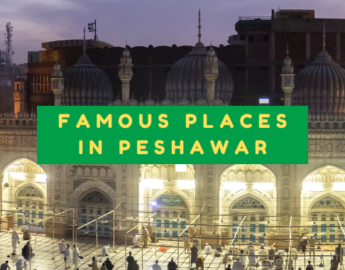Nowruz Celebrations in Pakistan; When and How to Celebrate 2023?
Table of Contents
Do you know how Nowruz Celebrations in Pakistan are done? Here we tell you all about it.
About 300 million people celebrate Persian New Year, and the celebrations in different regions have a history of 3,000 years. Here’s what we know about the festival. Iraqi Kurds hold fiery torches to celebrate
Nowruz – No-Rose or Persian for “New Day” – is an ancient festival in the northern hemisphere celebrating the first day of spring. Over 300 million people celebrate Persian New Year, which has been praised for over 3,000 years in the Balkans, Black Sea Basin, Caucasus, Central Asia, Middle East, and many other places.
Nowruz celebrations in Pakistan (New Persian Year) are observed on the first day of spring. Its roots can be traced back to Zoroastrianism, a pre-Islamic religion in Iran celebrated in much of the ancient Near East three thousand years ago. People worldwide, from West Asia and the Caucasus to Central and South Asia, including Pakistan, celebrate Nowruz for 13 days, each with its unique local variety. The phenomenon has also been observed in minority communities in the Americas and Europe, including Los Angeles, Toronto, and London. People love celebrating the colors, food, and uniqueness of diverse cultures in Pakistan.
What is Nowruz?
Nowruz, the celebration that marks the end of the previous year and the beginning of the new, is celebrated on the astronomical equinox, usually on March 21. The celebration lasts 13 days and is a chance to reflect on the past and set intentions for the future. The festival has its roots in Zoroastrianism, a religion practiced in ancient Persia that predated Christianity and Islam.
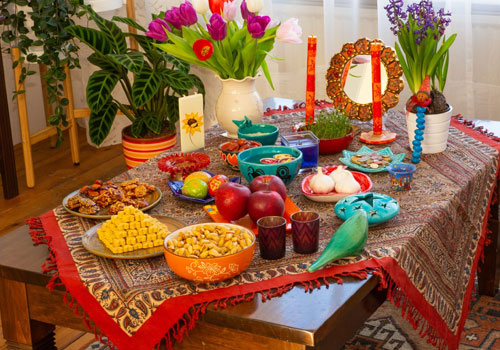
Nowruz table for a family gathering
According to UNESCO, the return of spring has great spiritual significance because it represents the success of joy over sorrow and good over evil. Unesco said: “The spirit of the nun, known as Rabithuina, is taken underground during the colder months by the spirit of winter and, according to Zoroastrian tradition, is celebrated at noon on Nowruz, welcome back .”
The festival and the celebration are part of UNESCO’s Representative List of the Intangible Cultural Heritage of Humanity, and in 2010 the United Nations General Assembly declared March 21 International Nowruz Day.
Also read; Nowruz Celebrations in Pakistan; K-P Invites Spring In Slightly Different Manner
The History and Significance of Nowruz Celebrations
The dominant Shiites in Pakistan have migrated from Iran, so they used to celebrate their traditional events there too. In addition to this, some Shiites who have not immigrated from Iran believe that since their native Iran commemorates the day, they should do the same as a way to present themselves as Shia Muslims.
According to some Shiite Muslim interpretations, Nowruz is the day when Hazrat Ali (may Allah be pleased with him) ascended to the throne of the Islamic Caliph. A small minority of Muslims consider Nowruz a day of cosmic step forward. On this day, Hazrat Adam was born. Some Muslims believe that Hazrat Ali was also born on this day.
Preparations for Nowruz begin a month before the festival. The four Tuesdays before Nowruz focus on different elements. The first is Water Tuesday, celebrating how water complements nature. The next day is Fire Tuesday, celebrating fire as a means of renewal. Then there’s Earth Tuesday, commemorating the rebirth of the planet. Finally, on a windy Tuesday, the wind blew away the buds, heralding spring.
Fire offerings are a paramount celebration aspect, with bonfires lit on the four Tuesdays leading up to Nowruz. Everyone has to jump into the fire on the last Tuesday of every month as a purification ritual.
Fire offerings are integral to the celebration, as bonfires are lit on all four Tuesdays leading up to Nowruz. The last Tuesday, everyone had to jump over the fire as an act of purification.
Like many Spring Festivals, cleaning and starting over are critical. Renewal-based activities such as spring cleaning, tree planting, making new clothes, and painting eggs are ordinary before Nowruz.
On the day before Nowruz, relatives’ graves are visited and tended before the whole family gathers around the table to enjoy traditional dishes. The table is decorated with a khencha, a large silver or copper tray with samani (wheat) in the center, and candles and colored eggs representing the number of family members around it. The party consists of at least seven courses.
Where is Nowruz celebrated around the world?
Nowruz begins on the vernal equinox when the sun crosses the equator, with days and nights of equal length. It is mainly observed in the Kurdish regions of Iran, Afghanistan, Iraq, and Turkey, as well as among Parsis in India and diaspora communities in other parts of the world. During Nowruz, people usually wear different colors according to their culture, such as dark green, dark red, black, and blue.
Due to its origins, the festival is prominent in countries with influential Persian cultural influence, including;
- Kyrgyzstan,
- Afghanistan,
- Pakistan,
- Azerbaijan,
- Turkmenistan,
- India,
- Kazakhstan,
- Turkey,
- Tajikistan,
- Uzbekistan.
Nowruz Celebration in Iran
Iranians from all over the world are getting ready to celebrate Nowruz: the Persian New Year. Iranians clean their houses thoroughly. Cleaning is called “sweeping dust,” which represents the wish to eliminate old things and welcome the new.
The arrival of spring means the end of the cold season and the arrival of extreme heat. But it’s more than that for many countries in the Middle East and Central Asia, especially Iran. For the people of Iran, the arrival of spring is an ancient tradition, a celebration rooted in history, and a celebration of the growth and power of Mother Nature.
Navruz In Turkey
Türkiye is one of the countries where Navruz also has a special status. Navruz, which means “new day” in Persian, marks the advent of spring each year and is celebrated across vast swaths of the Middle East, Caucasus, South Asia, and the Balkans.
Known as the “Pearl of the East,” Van in eastern Turkey received a record-high number of tourists during the Nowruz festival this year. Locals welcome tourists celebrating the festival, but the influx has brought new challenges to the city.
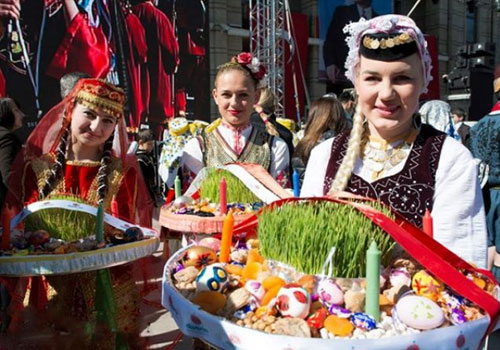
Nowruz Celebrations in Turkey; A girl is presenting food.
In many Turkic-speaking countries of Central Asia, Nowruz is Yenigun. Some communities in the region have been celebrating the festival for thousands of years. However, Professor Irber Ortelli, a famous Turkish historian, believes that Nowruz was originally an Iranian festival.
In Mersin-Silifki in southwestern Turkey, Turkmens celebrated the day by shooting into the air. In Gaziantep in southern Turkey, Nowruz is known as “Sultan Navriz,” which means King Navruz.
The day is celebrated in Giresun on the Black Sea coast as harvest time. For many people across Turkey, the beginning of spring is a symbol of joy and happiness. Despite Nowruz’s historical and traditional significance, the day lost its meaning in Turkey for political reasons after the fall of the Ottoman Empire.
However, Kurds have celebrated the day in southeastern and eastern Turkey for decades. The occasion has become necessary to symbolize the Kurdish people’s revolt. Nowruz is thus a day of protests and a challenge to the Turkish government in the Kurdish-majority region.
But finally, at a private event in Ankara in 1994, Nowruz was embraced by Turkey’s most senior officials. In 2005, the Turkish Ministry of Education asked the country’s educational centers to designate March 21 as one of the national student holidays.
Nowruz in Tajikistan
These countries’ different religions and cultures have established their own celebratory traditions, including feasting, visiting relatives and friends, and exchanging gifts.
An ancient national holiday in Tajikistan celebrates the start of the Persian new year and is the key to friendship and rebirth in the country. People of different nationalities and religions in Tajikistan have celebrated Nowruz for thousands of years, but the ceremonies have been restricted for years by the country’s Soviet government.
However, the country’s independence led to the revival of ancient customs, and Nowruz was renamed as a symbol of Tajik culture and identity. Since 2011, Tajikistan’s president has emphasized the importance of respecting the traditions of Nowruz.
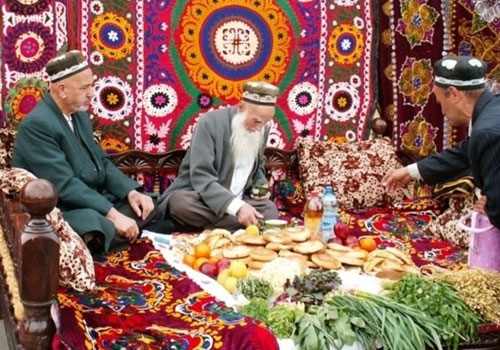
Nowruz Celebrations in Tajikistan in full colors
Tajiks start celebrating a month before the spring equinox. During the first three days of the last month of each year, family, relatives, or friends gather around a campfire to celebrate with songs, music, and games. “Hout” is the name of the calendar’s last month.
Nowruz celebrations on the northern astronomical equinox, usually held on March 21, are known in the country as Khidr Ayyam (Great Eid). Customs associated with it include special rituals for good health, prosperity, blessing, and abundance. Tajiks also prepare spiritually for Nowruz by paying off debts and forgiving old insults.
Nowruz in Kyrgyzstan
The unique festivals in Kyrgyzstan. Nowruz, which means “new day,” is celebrated every March 21 in Kyrgyzstan, Central Asia, and other countries. Celebrate with the beginning of spring, which is a time of family and village gatherings. Participating in Nowruz celebrations is an original way to learn about Kyrgyz culture and spend an unforgettable time in Kyrgyzstan.
In Kyrgyzstan, Nowruz is a national holiday celebrated with great interest and festivities. Towns organize significant events at this time. These are concerts by local traditional musicians, folk dances, and Bedouin games. For example, you can watch traditional fighting games or the famous Kok Boru (buzkachi), a game of horses with sheep or goats.
In Novruz, the Kyrgyz cook sumoluk, a wheat soup. It is traditionally baked in large pots on the streets 24 hours before Nowruz. Village women help each other cook soup. Some Kyrgyz also throw stones into the soup to make a wish.
Kyrgyz tables are filled with delicious traditional dishes such as fried bread, borsuk, plov, or beshmark. Nowruz is also a time of competition, as the Central Asian nation loves to cook up many traditional dishes and try to enter the Guinness Book of World Records.
Nowruz is the perfect time to plan a trip to Kyrgyzstan. It’s not the tourist season, and it’s an ideal time to explore Kyrgyzstan’s culture and traditions. The Kuk-boro match was held at the main stadium in Bishkek, the capital of Kyrgyzstan. Ala-Too’s Main Plaza has performances most of the day. Make the most of your holiday in the village by learning how to cook traditional Kyrgyz dishes from your hosts and celebrating Nowruz with a local family.
How are the Nowruz celebrations in Pakistan done?
Shia, Ismaili, and some Hazara communities in Pakistan observe Nowruz, but others do not. Balochi people are usually present at the celebration of this traditional event.
The themes of purity and rebirth are at the heart of many spring celebrations. People clean, plant trees, make new clothes and decorate eggs, which remain popular activities focusing on revival ahead of Nowruz.
On the day before Nowruz, relatives’ graves are visited and tended to, and the whole family gathers around the table to eat traditional dishes. A khancha, a large silver or copper dish with a samani (wheat) in the center surrounded by candles and colored eggs denoting the number of family members, will be placed on the table. At least seven courses are served at the banquet.

Nowruz Celebrations in Pakistan; A picture shared by a Twitter user
How do people celebrate Nowruz?
Celebrations vary from country to country, but there are some common traditions.
These include symbolic fire and water preparations and ritual dances that sometimes involve jumping over a campfire. The flame symbolically purifies terrible experiences from the previous year.
Traditional spring cleaning occurs in homes before Nowruz, and people gather with family and friends during the festivities. Before the new year, families exchange wishes, elders distribute sweets, and children receive coins and gifts. But one of the most important traditions is preparing the Haft Sen table. In the town of Accra near Duhuk, Iraqi Kurds held fiery torches to celebrate Nowruz, the first day of spring, and the Persian New Year.
Wonderful #Nowruz celebration in Pakistan. Lovely people, amazing food and beautiful music 😊 truly a celebration of different Central Asian cultures. 'No' is new and 'rouz' means day in Persian. Therefore, Nowruz signifies new day and new beginnings. Nowruz Pirooz! pic.twitter.com/J8T1Lokz6R
— Sana Jamal (@Sana_Jamal) March 24, 2019
Haft Sin table; A Traditional Table in Nowruz Celebrations
The Haft Sen table, or a list of seven things starting with the letter S, is a family activity. Usually, a unique home cloth is laid on the table first, and then seven items are placed. They can include:
- Serkaa (vinegar): Represents age and the patience that comes with age
- Sikkah (coin): for wealth and prosperity
- Seer (Garlic): Health Benefits
- Seeb (Apple): For Health and Natural Beauty
- Sab zeh (wheat): for rebirth, renewal, and good luck
- Samanu (wheat pudding): a dessert of richness, fertility, and the sweetness of life
- Sumac: A Celebration of Dawn and a New Day
In addition to these items, the dining table could include a mirror to symbolize the past year, eggs to represent fertility, goldfish to represent new life, and candles to express light and happiness.
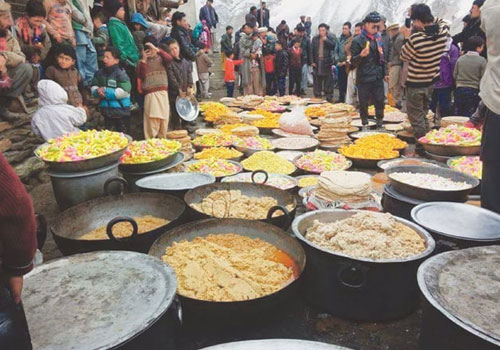
Nowruz Celebrations in Northern Pakistan where a variety of food is being served.
Various dishes are prepared during the festival, but “Rushdie,” or noodle soup, is often served, which is believed to symbolize “the many possibilities in one’s life,” according to Harvard University.
Unique sweets, such as baklava and dragees, are also believed to bring good luck and are shared during the festivities. Many other dishes include fish served with special rice made with green herbs and spices, symbolizing the nature of spring.
Nowruz Dates and Calendar 2023
Nowruz, an optional holiday in Pakistan, falls this year on March 21, 2023. Schools and businesses are open as usual that day.
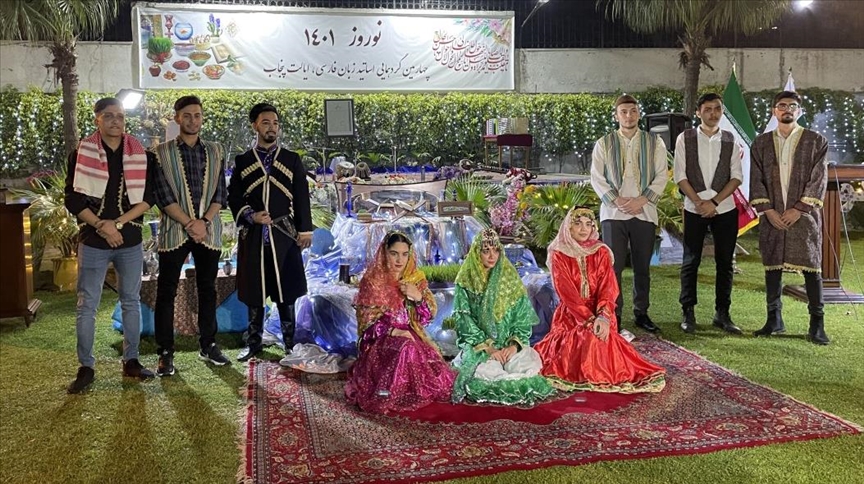
Nowruz Celebrations In Pakistan; A tableau is presented by young girls
Nowruz Color 2023
During Nowruz, people usually wear various colors according to their culture, such as dark green, scarlet, black, and blue.
Final Thoughts
Nowruz celebrations in Pakistan is a popular festival celebrated in Pakistan. It marks the start of spring and celebrates the renewal of nature and life. It is celebrated on the first day of spring, which falls on March 21st each year. People from all over the country gather to celebrate this occasion with traditional music, dance, food, and festivities. The celebration includes exchanging gifts, feasting delicious food, and lighting lamps to signify the light of knowledge. People also participate in activities such as kite-flying competitions and horse-racing contests. This festival brings people from all walks of life, celebrating their culture and heritage with joyous festivities. If you are on a Pakistan Tour and want to observe the different colors of the culture here, participate in this kind of celebration to see the actual colors.




